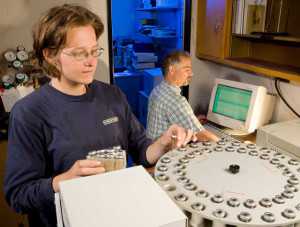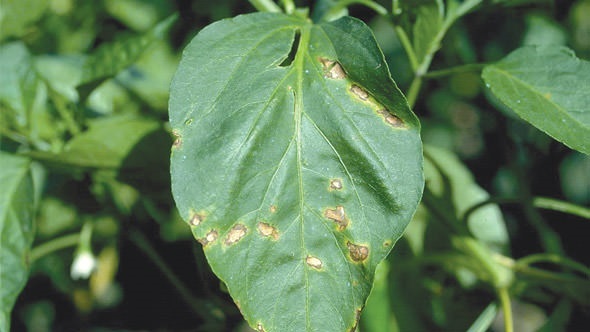Study: The Link Between Fertilizers And Greenhouse Gas Emissions

University of Minnesota technician Sonya Ewert (left) and ARS soil scientist Rodney Venterea use a gas chromatograph to determine amounts of greenhouse gases in samples collected from fields.
Photo credit: Stephen Ausmus
USDA researchers are learning more about the mechanics of how nitrogen fertilizers contribute to the development of greenhouse gases. These studies are being conducted by Agricultural Research Service (ARS) soil scientist Rodney Venterea.
Nitrous oxide can absorb 300 times more radiation than carbon dioxide. After the application of nitrogen fertilizers, soil microbes can convert nitrogen into nitrate and then into nitrous oxide. However, Venterea suspected nitrous oxide emissions are even more strongly correlated with levels of nitrite, another form of nitrogen that is not commonly measured.
Venterea conducted a study in maize over two growing seasons that examined the effects of different nitrogen fertilizer sources and application methods on nitrous oxide. The fertilizers were conventional urea, polymer-coated urea, urea infused with microbial inhibitors, and a 50/50 mixture of conventional urea and urea with inhibitors.
Venterea’s results indicated that nitrous oxide emissions were strongly linked to soil nitrite levels, which accounted for 44% to 73% of the variation in nitrous oxide emissions.
The results also showed that the lowest levels of nitrite and nitrous oxide occurred with the fertilizer that contained urea-infused microbial inhibitors. The 50/50 mixture also reduced both nitrite and nitrous oxide.
Venterea says he believes that nitrite can produce nitrous oxide quickly under a broader range of conditions, especially when soil is in an oxygenated condition, which it tends to be most of the time except following large rainfall events.
Venterea works in the ARS Soil and Water Management Research Unit in St. Paul, MN. He and his co-author, University of Minnesota graduate student Bijesh Maharjan, published these results in 2013 in Soil Biology and Biochemistry.
This work was conducted as part of GRACENET (Greenhouse-Gas Reduction through Agricultural Carbon Enhancement Network), a national network of ARS research projects investigating the effects of management practices on soil carbon sequestration, trace gas emissions, and environmental quality.
Read more about this work in the May/June 2014 issue of Agricultural Research magazine.
Source: Ann Perry, USDA Agricultural Research Service Information Staff










